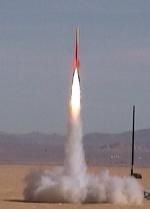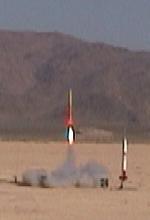LaserLOC 2.1

| Diameter: | 2.25" | Type: | High Performance |
| Length: | 44" | Status: | Active - 8 flights |
| Motor Mount: | 54mm | Build Dates: | 1999-06-01 to 1999-11-01 |
This is one of my favorite rocket kits. It is a minimum diameter 54mm rocketthat has a fiberboard airframe (my preference to phenolic), DADO slotted G10 fins, and a custom turned wood nose cone. I ordered this kit via telephone. Ron and Deb were awesome to work with, and the kit came with original mimeographed instructions and a hand-signed note from Deb. This kit obviously was custom because it took three weeks to get. But when it arrived it was well worth the wait!
Flights
The Laser/LOC was pretty dusty after sitting around for ten years, so what better way to clean it off than by putting it up on a long burn full J? The weather gods smiled on this flight with a clear, windless morning, but I had installed my trusty ComSpec tracker just in case. Also going for a ride was the ever-reliable Stratologger (knock on wood!) for deployment control. The Laser/LOC roared off the second rack of the day on a long white flame and quickly headed out of sight on a rail-straight column of smoke. The tracking signal jumped at apogee, and we were able to quickly recover the bird a short drive from the pad, beeping out well over 2 miles in altitude.

others: higher up
Well, I finally found time to repair the Laser/LOC from its last flight, with one wrap of 6 oz. fiberglass over the kinks in the tube. With the recent acquisition of a 38/1080 case, I decided to finally put up the J570W I had been hoarding for three years. We had it prepped and on the rack in no time, and the count was called out and then... nothing. The rocket sat around like a fat pig for 4-5 seconds, when WHAM! the J570W came up to pressure and the rocket TORE off the pad. Guess that old AT propellant takes a little bit to get it going ;) The (cardboard, mind you) rocket survived the boost and two seconds of flight over mach. It then coasted WAAAAAAAAAY up to apogee, which came and went. It looked like we were having a repeat of flight # 8 when the ARTS finally decided it had reached apogee and fired the deployment charge. Alas, it was too late, and the shock cord tore in two, giving the booster a 2" zipper and leaving the payload section to its own devices on a 28" parachute. The booster came in flat, aided by the giant shock cord streamer trailing it, and sustained a kink at the top of the fiberglass repair job from last time. Oh well, a little more fiberglass and it'll be all better again. The payload section, on the other hand, decided to be funny and drift off the lakebed into the bushes. It took us until 3:30 in the afternoon to find it, all the while being chased by the Lucerne yokels firing shotguns at us. Scary stuff. But we finally found the payload section, beeping quietly behind a bush. This rocket will be ready to go again soon... next time on a J800T!

others: now you see it | now you don't
After almost two years in hibernation, the Laser/LOC made a great showing for its next flight. I had an I65W sitting around from June of 2001 that just wanted to be burned, and there is no better rocket for one than a minimum diameter vehicle. So we stuck it in this rocket. I rigged up the RRC2 for dual deploy, and we took it out to the pad early. I inserted the QuikBurst igniter and armed the altimeter. All was good to go and after a couple photos, we stepped back and let the LCO hit the button. The motor came up to pressure in about 2 seconds, and then the rocket made a slow ascent. It kept going and going and going. After burnout, we lost track of it. I had sent the darn thing into orbit. However, Rick Magee called out that it was down, and something was deployed. We recovered the rocket about a half mile from the flight line. Apparently, the RRC never fired the apogee charge, but did fire the main charge. Thanks to strong modular construction, there was no damage done to the rocket except for a MAJOR zipper in the replaceable main compartment. Unfortunately, we also lost the data, and as such we lost the altitude. I think it went about 10,000 feet. That was COOOOOOL.

others: preflight | still going
video
At LDRS XX, hosted by ROC and LTR, I decided to fly the J460 in this rocket. We were on the lakebed at 6:00, prepped this rocket, and stuck it on the pad around 7:00. After a 5 count, Rick DuVall punched the button. A brief delay ensued as the motor came up to pressure, then BAM! it was gone. I managed to catch one glimpse of the rocket on the way up, and that stop frame is embedded in my mind forever. It is of the rocket up around 7,000 feet with a blue flame as long as it, screaming upwards. After burnout, we followed the delay trail and waited. And waited. And waited. And waited. Finally, the trail terminated in a puff, signaling deployment of the parachute. Out came the orange dot, and away we went. We followed it all the way down (through the national anthem) and lost it in a haze layer above the lakebed. Great. Now what? We waited for the rocket to touch down, and then began our search for it. After hiking out to the radio towers (~3 miles), we headed back in for some water and replanning. I went up to the LCO table to have them announce if anyone found our rocket, and described it to them. Then the lady (I don't remember who) held up the rocket and said "This one?" Well, yeah. Someone found it and brought it back. Thanks a lot, but it's not nice to do that for someone. What if the motor kicked out or the rocket broke or something? We like to see how our rockets land to diagnose the damage. So please, if you see someone's rocket laying on the ground, DON'T PICK IT UP!!! Of course, if the rocket has been pronounced lost or if it's your rocket, go right ahead, but leave the rocket there as a courtesy to other fliers. All that we lost was about 2 hours of flying time. We were lucky. Back to the flight, we downloaded the ALTACC data and got our highest reading ever: 11,487 feet! Woo hoo! We also busted mach (~1500 ft/sec). What a great flight.
At ROCStock 12, I decided to go for broke with a J275 in this rocket. The 54mm baby J whipped the rocket off the pad to an ALTACC recorded altitude of 10,288 feet! This was my first flight ever over 10K high. I had ignition troubles in the beginning (Daveyfire with pyrogen didn't light it) but then my friend Ken Finwall of CHPMR gave me a piece of Thermolite. That lit the rocket right up after a 5 count. The Laser streaked off the pad and held together through the entire burn. It even came down close, landing perhaps 1/2 mile away. The medusa nozzle filling up the entire back end of the rocket with flame was spectacular. What's next? There is this little voice in my head that is saying "J460! J460!" Sounds good to me...
Very cool flight that flew off the first row. (The LTR layout put the first row at the minimum I safe distance, so this was extra cool.) The LCO counted down and touched the button and BAM! the rocket was gone. This is the coolest combo ever. We were lazy on this flight and didn't stick in electronics, but previous flights of the same combination said around 7000 feet and just below mach.
Well, now I had a pile of I435Ts and no Arcas to fly them in, so we put one in the Laser/LOC for fun. The motor lit right up and the Laser/LOC shrieked into the sky like a bullet, quickly receding from sight. The motor shut down, and in the ensuing silence, the blast deflector could be heard ringing from the liftoff! The rocket arced over at apogee and deployed its chute way up there, and I chased it down with ease. Awesome flight!
This was the first flight of our shiny new Mach-busting rocket, on an H123W to test the rocket and the ALTACC and make sure we could get data back to show we had gone Mach. Of course, Murphy got tucked into the payload section next to the ALTACC, and the Laser/LOC cracked a fin on landing after a beautiful boost. Heavier fiberglass next time...

